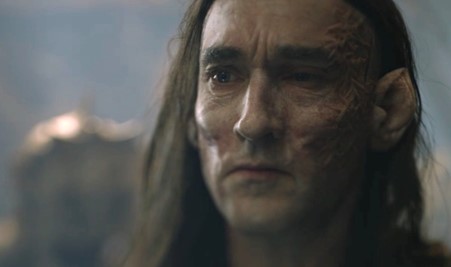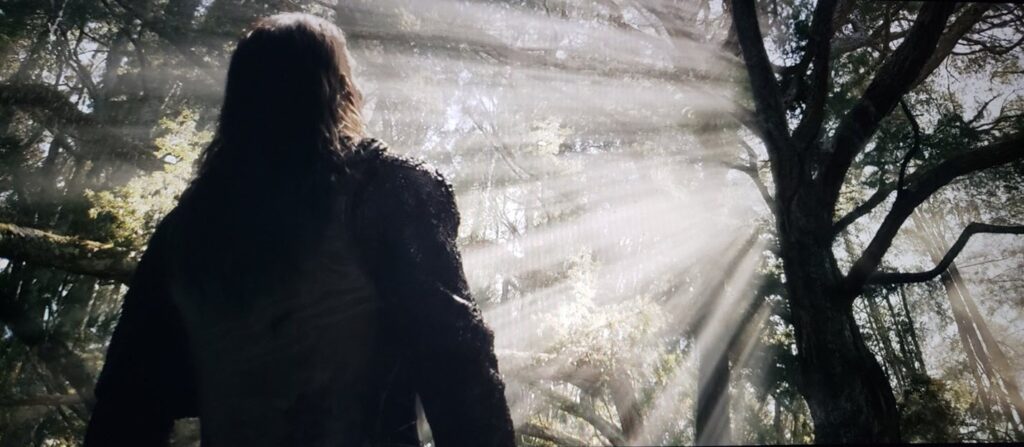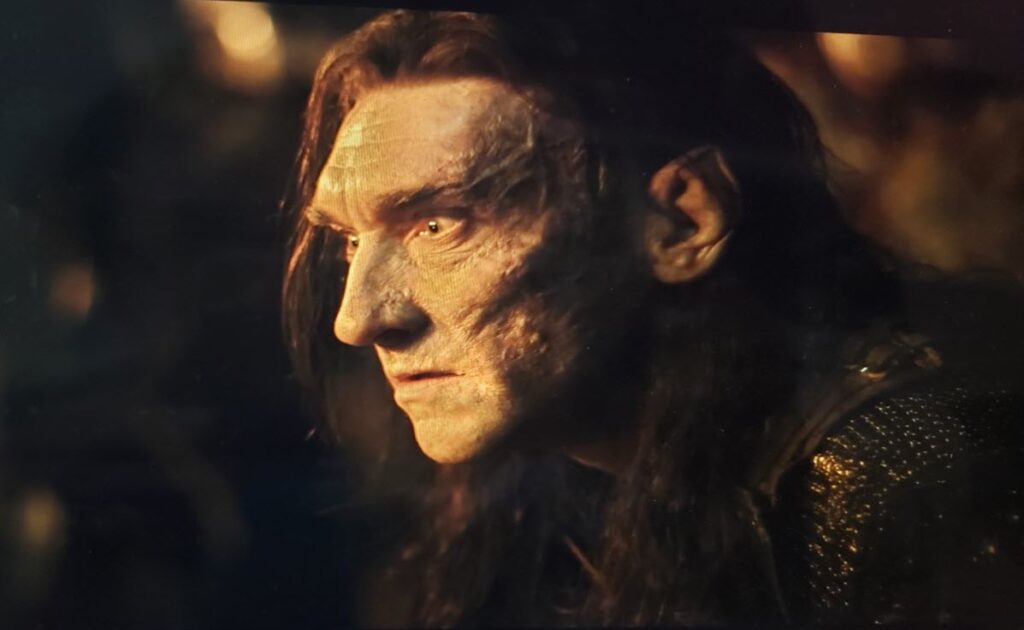The following is a guest post from Grace Khuri:
Now that half of season 1 of The Rings of Power has been released there is more than enough thought-provoking material to inspire fascinating discussions and spur vigorous debates.

Who is Adar?
In episode 4, we are formally introduced to the great elf of mystery, Adar, superbly acted by Joseph Mawle. There has been fervent and tireless speculation regarding this figure’s identity: his armour suggests he is one of the Noldor and his casting breakdown characterized him as having an air of “fallen nobility.” Is he one of Galadriel’s brothers? Or perhaps Maglor, Fëanor’s second eldest son, an infamous figure wandering the world in remorse over his family’s oath-driven crimes and grieving his dead father and brothers? Or is he merely a composite of various “problem elves” from The Silmarillion like Eöl, Maeglin, and the Fëanorians?
Ancient grief and suffering
Whatever the case, Adar is portrayed as a tortured and complex figure full of turbulent memories and sorrow, but also ambition. When his blurred face comes into focus for the first time, it is deeply engraved with the markings of ancient grief and past physical suffering. His arrival to quickly (and surprisingly with great remorse) dispatch a slowly dying orc seems a continuation of some still hidden traumatic personal history. Perhaps his subsequent conversation with the captive Arondir is punctuated by noted silences and elliptical statements because of his own trauma.
In a second, much shorter scene, Adar watches a caged warg devour what appears to be the arm of one of Arondir’s recently fallen comrades. Disturbingly, Adar views the atrocity not with a blank, numbed stare, or perhaps even a hint of sadness, but with a glint of malignant pleasure. In spite of the phenomenal costuming, makeup, cast and acting, here enters the problem of Adar.
The “spell of bottomless dread”
Many elves of the First Age were captured and tortured by Morgoth, signs of which are physically and emotionally apparent on Adar; in earlier iterations of The Silmarillion like The Book of Lost Tales (written c. 1917-1919), numerous elves were placed under the “spell of bottomless dread” – a state of spiritual terror that all but guaranteed that any who escaped (or were intentionally released) continued to perform the will of their captor. Because of this spell, many such elves were mistrusted by their own people and forced to live as outcasts.
Maeglin
In The Fall of Gondolin (1917), the elf prince Meglin (older variant of Maeglin) is captured and put under the spell to ensure he will follow through on his commitment to aid Morgoth’s siege. When he is sent back, he lives in misery and terror until the time is ripe for the attack. In the later variant of the story published in The Silmarillion, the captive Maeglin, “no weakling or craven”, relents at the threat of what is implied to be some extreme torture. Tolkien’s surprising characterizations of Maeglin as “wise in counsel” and “hardy and valiant in need” reveal admirable qualities in an otherwise unredeemable figure. Tolkien’s moral tragedy not only endows villainous figures with psychological realism, but expresses implicit regret over the good qualities being snuffed out by their own failings and Morgoth’s corrupting influence.
Gwindor
Adar also resembles the First Age elf Gwindor, a lord of Nargothrond who fought in the Battle of Unnumbered Tears (which Tolkien biographer John Garth, in his book Tolkien and the Great War, has linked with the Battle of the Somme). A heartbreaking portrait of a war-hero turned marred captive, Gwindor witnesses the brutal, public execution of his brother in battle and wrathfully charges the gates of Angband, where he is captured and held as a labouring thrall for a long period. He later escapes and is found by Túrin Turambar’s elf friend, the hunter Beleg Cuthalion:
Grieving Beleg looked upon him; for Gwindor was now but a bent and fearful shadow of his former shape and mood, when in the Nirnaeth Arnoediad that lord of Nargothrond rode with rash courage to the very doors of Angband….
(The Silmarillion, Chapter 21: “Of Túrin Turambar”)
Over the course of the narrative, “strength and courage” return to this broken figure Gwindor, but his suffering continues as he watches the love of his life, Finduilas, turn her affections away from him to the (physically) unmarred Túrin.
Captives, POWs, and war veterans
This deeply affecting portrait echoes the many valiant young men coming home from WWI’s Battle of the Somme and other fields of war broken in body and mind, and, in many cases, greatly disfigured. Indeed, more widely, Tolkien’s portrayal of First Age elves includes their suffering as captives, P.O.W.s, and war veterans, echoing real-life soldiers returning (or not returning) from the torn battlefields of France and Belgium.
Depictions of violence against deceased elves are treated with horror and associated with the deepest darkness; Morgoth gives fallen elven heroes to his demon wolves. Sauron perpetrates similar atrocities, sending werewolves to devour the brave elven company of Finrod Felagund. But no captive or even the most morally-corrupt elf in The Silmarillion sinks to the utterly debased enjoyment of beholding post-mortem desecration. This was reserved for the dark lords themselves.
Grossly out of character for Tolkien
If we accept the proposition that Adar is a P.O.W. from the First Age, his disturbing reaction to a warg devouring the remains of a fellow elf is grossly out of character for Tolkienian portrayals of such figures. Adar’s hideous reaction in this scene is something that not even the worst fallen Elves of The Silmarillion would have exhibited, even the violent sons of Fëanor or the treacherous father and son, Eöl and Maeglin.
Written as is, it reflects a profound misunderstanding of Tolkien’s depictions of the captivity, trauma, and moral corruption of the Firstborn. Perhaps the writers attempted to “Game of Thrones-ize” this Noldorin Elf with this bit of gratuitous horror, part of a wider cycle of gruesome scenes in other episodes, by adding more prurient depictions of violence whilst just managing to stay within the TV-14 rating.
A grave disservice to Tolkien’s literary legacy
This second Adar scene not only exhibits a grave misrepresentation of traumatized First Age elves, worse still (although surely unintentionally), it does a grave disservice to Tolkien and his literary legacy. Amongst many Tolkien scholars, it is commonly believed that the valiant but doomed elves were modelled on the real young men made “perpetually youthful” due to their premature deaths in battle.
In his 1936 British Academy lecture, “Beowulf: The Monsters and the Critics,” Tolkien himself obliquely pointed to this connection when he said, “Even today…you may find men not ignorant of tragic legend and history, who have heard of heroes and indeed seen them.” Tolkien’s doomed elven warriors are the mythologized equivalents of the fallen youth depicted in British soldier Laurence Binyon’s “For the Fallen” (1914):
They went with songs to the battle, they were young,
Straight of limb, true of eye, steady and aglow.
They were staunch to the end against odds uncounted;
They fell with their faces to the foe.
They shall not grow old, as we that are left grow old:
Age shall not weary them, nor the years condemn.
With this in view, portraying a depraved Adar smirking at mutilation and post-mortem desecration is not in the spirit of Tolkien’s authorship, himself a war veteran who wrote in a letter of the “animal horror” of the Somme, where he served.
Empathy and sadness
Due to his experiences, Tolkien featured noted scenes of violence in his legendarium with the empathy and sadness of one who had seen the bodies of countless wounded, mutilated, and dead youth. This, I believe, is why The Silmarillion includes such poignant episodes depicting the retrieval of bodies of noted elven heroes like Fingolfin and Glorfindel. After Fingolfin’s valiant but doomed fight with Morgoth, the dark lord “took the body of the Elven-king and broke it, and would cast it to his wolves,” but Manwë’s chief eagle, Thorondor, prevents this atrocity, returning Fingolfin to his son Turgon, who then “built a high cairn over his father” which “No orc dared ever after […] draw nigh” (The Silmarillion, Chapter 18: “Of the Ruin of Beleriand and the Fall of Fingolfin”).
Such incidents were likely influenced by heart-wrenching recollections of the significance of finding dead soldiers on foreign battlefields from which so many were never recovered. Tolkien’s own two closest friends, Robert Quilter Gilson (d. July 1, 1916) and Geoffrey Bache Smith (d. December 3, 1916) perished in France and had proper burials, but others Tolkien knew did not (note that the body of Fingon, Fingolfin’s son, was never recovered).
Time for deeper reflections
In their choices regarding depictions of violence, if the writers of this show would like to continue in a more Tolkienian vein, it may help to reflect more deeply on the real events and casualties behind the Somme battlefield-like images they re-created as well as Tolkien’s tradition of historically-inspired elven P.O.W.s, which are the template for Adar. Rather than succumbing to the temptation to emulate darker, more prurient fantasy series like Game of Thrones or its successor, House of the Dragon, it is my hope that in the future the showrunners will take a higher road in relation to the source material they are adapting, remembering its more poignant and tragic origins.
Postcript: Heart of Darkness (spoilers)
The piece above was written before the release of episode 5, where Adar plays a larger, and still darker, role. Even with the newest episode, critical questions remain unanswered.
In line with this episode’s title,“Partings,” Adar’s first scene is symbolically rendered as he stands at the edge of a forest gazing into the sun in a prolonged mesmerized state. His face is filled with the sun’s glow, in contrast to the orc -completely intolerant to sunlight- who stands hooded, with its back turned. Adar, commands the orc to uncover its arm, which burns and smokes in the sunlight, and says, “I wish you could feel it like I do – for soon it will be gone – and with it, the part of me that knew its warmth as well. I shall miss it.”

A twilight in Adar’s soul
This profound statement marks a twilight in Adar’s soul, as he is about to make his final descent into moral darkness, choosing to snuff out any last remnants of conscience and nobility. His pensive response to the blazing sunlight, which bathes his face in a way that recalls his once unfallen state, is so striking that it seems possible that he, as one of the Noldor, is recalling the light of the Two Trees of Valinor. This conjecture is supported by the fact that, in an earlier episode, Galadriel herself says she can still feel the warmth of the Trees on her face.
Adar’s equation of the quenching of the light with the extinguishment of his former self reveals a hint of regret; if his emotional reaction to the sun is at all laden with memory of the Trees, it is also symbolically weighted with The Silmarillion’s potent themes of exile and Fall. The destruction of the Two Trees by Morgoth marked not only the “Darkening of Valinor,” but also the moral darkening of Adar’s kin, the Noldor. Adar’s remaining scenes in this episode are notably all at night, marking his descent into deeper inner darkness. However, there is another problem which needs to be thoughtfully addressed by the writers.

And a third time
Waldreg, a Sauron loyalist, leads a group of Southlanders to Adar, mistaking him for the dark lord. Adar’s eyes burn with subdued anger as the group approaches and he turns his back when Waldreg addresses him. If the writers are hearkening back to the First Age, these men may be the descendants of those who betrayed the Noldor at the Battle of Unnumbered Tears centuries earlier, possibly explaining Adar’s reaction.
Delighting in the prospect of his people being raised out of the “muck and the filth”, Waldreg tells Adar that they can now, “… take their rightful place at your side.” At this last statement, Adar’s downcast eyes flit upwards, and when an increasingly doubtful Waldreg asks, “You are Sauron, are you not?” Adar snaps. The elf whips around and rushes at Waldreg, violently slamming him to the ground.
What Adar does next is, again, out of character for even the darkest elven villains of The Silmarillion, being more characteristic of Sauron and Morgoth. Adar grabs Theo’s young friend, Rowan, forces him to his knees in front of Waldreg, and throws a dagger at the old man, declaring, “Only blood can bind.”
Strangely, this does not involve Waldreg’s blood: instead, he must prove his fealty by enacting a blood oath using human sacrifice, just like the Southlanders’ dark past of Morgoth-allegiance, and embodied in stone relief at Ostirith of a sword piercing a prostrate victim. Adar’s requirement that Waldreg shed someone else’s blood is not attributable to any vindictive logic of revenge, as Rowan is not Waldreg’s son or relative; instead, it forces Waldreg into debased cruelty. Some would argue that this choice indicates Adar’s inner orcishness, not yet fully manifested in his physical appearance, which largely retains its elvish characteristics.
Please explain. Carefully.
However, this disturbingly Sauron-like behavior (whose very name reignites Adar’s ancient, suppressed wrath) needs to be carefully explained in future episodes. Elves, especially the Noldor, were famed for their fierce hatred of Morgoth and his servants, and were not lightly turned to the outright diabolical viciousness Adar exhibits. In Tolkien’s writings, unlike men, elves were generally only swayed to commit such deeds of orcish barbarity (here infused with malevolent spiritual darkness) by coercion-based corrupting influence, as with Maeglin.
While the show may imply that Adar seeks to take Sauron’s place and achieve the same level of god-like power, the audience needs to see why Adar is emulating the devilish cruelty of the being (likely his former tormenter) he hates so much. This necessitates more detailed exposition informed by a thoughtful engagement with Tolkien’s writings. The audience is shown the end of Adar’s character arc; it now needs to see the hidden history and undeveloped subtext unfold (perhaps in flashbacks to an uncorrupted Adar in the First Age) in order to do justice to Tolkien’s depictions of such figures in his mythology. Without that, the writers would be woefully remiss in their handling of Tolkienian moral tragedy.
Guest author Grace Khuri is a doctoral researcher at the University of Oxford writing the first Ph.D. thesis on Tolkien at that institution. Her work considers the symbiotic influences of Old Norse mythology and the First World War on the ‘Silmarillion’ corpus and how these inform and enrich its dynastic tragedies and falls of kingdoms. Her interests include Old Norse myth and sagas, First World War cultural and military history, medieval literature, medievalism, filmmaking, and film criticism. You can reach her at grace.khuri@ell.ox.ac.uk.




